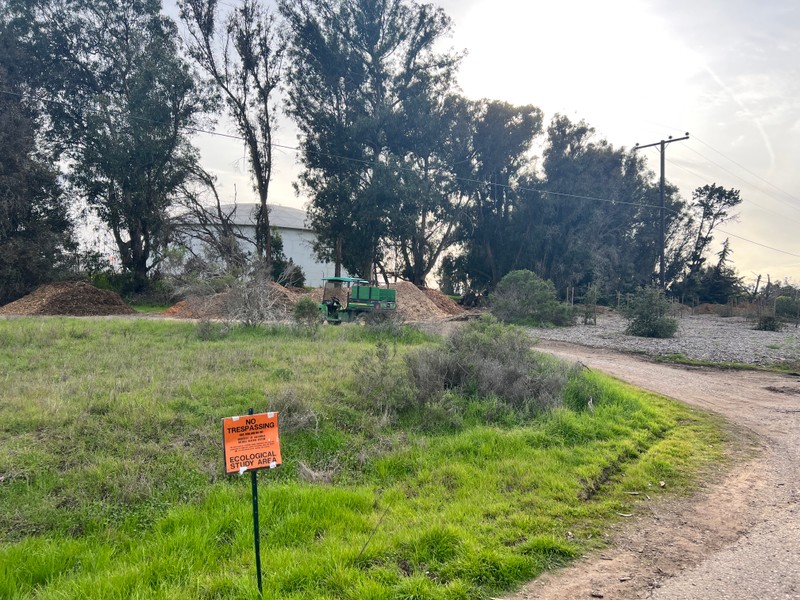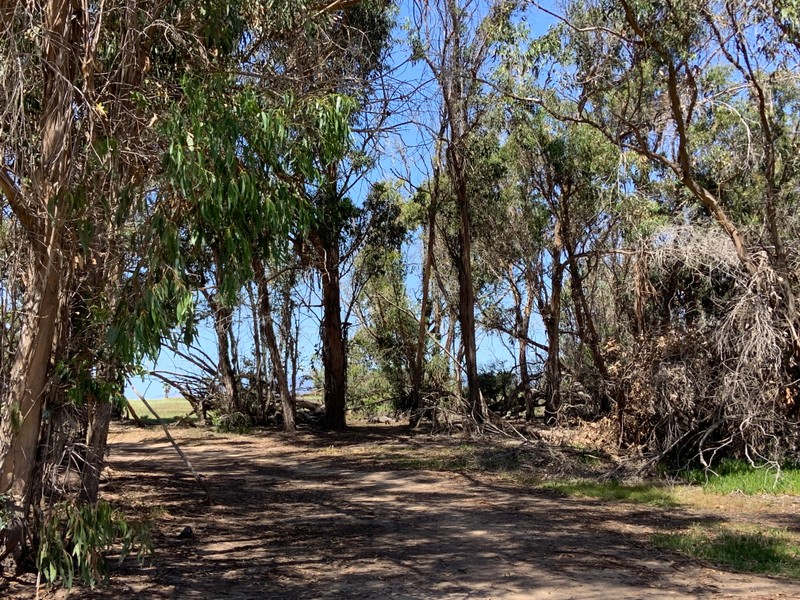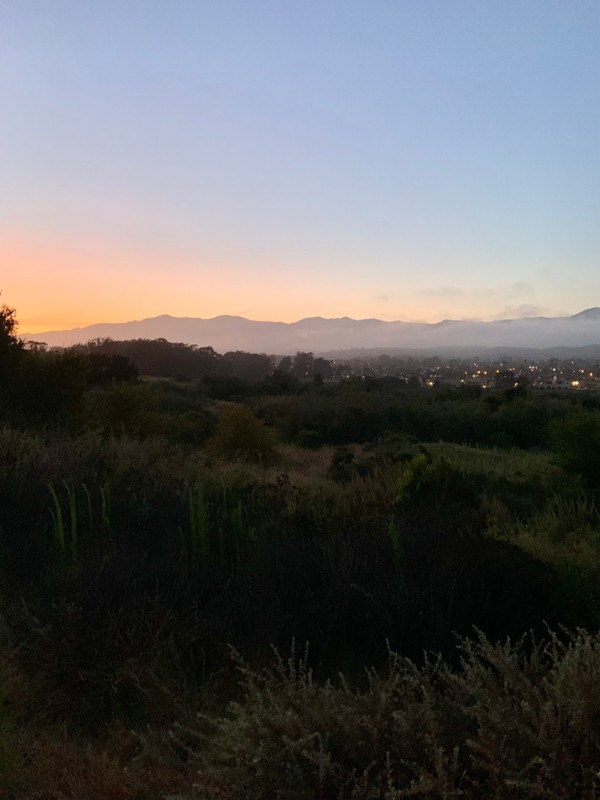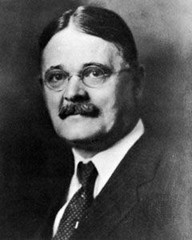Eucalyptus Grove
Introduction
Author-Uploaded Audio
Listen to a narration of this entry's description by Nicky Rehnberg.
Text-to-speech Audio
Recommended Time: 10 minutes
When you have finished up on the Coal Oil Point Pond Trail, walk back down to the road and turn left to continue uphill. Slow your pace and look around. On your right, you should be able to see the Santa Ynez Mountains. Depending on the season, the light hits them perfectly the hour or so before sunset. They glow pink and it almost looks as if they are shimmering. How many houses do you see out there between you and the mountains? How many people do you think live out there? How many of them do you think have walked the trail you are walking on?
Keep walking on the path. When you are at the top of the hill, look to the left. There you should see a huge, white, domed building. This is oil infrastructure: a storage tank for crude oil. It shouldn’t surprise you at this point to know that the road you just walked up was an oil company access road built to service the tanks you are standing next to. While you walk on these trails keep your eyes open for signage that warns you about nearby pipelines or infrastructure.
As the road winds to the left you should see some bigger trees up ahead. Walk to them. They are Eucalyptus (and they are very friendly and fragrant)! These trees were planted over a century ago, and they were part of a bigger movement to introduce non-local plants to this environment. There were a few reasons to do so, and you can read more about them in the next section.
Images
Oil Storage at Ellwood Devereux

Eucalyptus Grove

Shimmering Santa Ynez Mountains

Frederic E. Clements

Backstory and Context
Author-Uploaded Audio
Listen to a narration of this entry's description by Nicky Rehnberg.
Text-to-speech Audio
Many introductory species have been planted at Ellwood Devereux, but the two with the most impact are Pampas Grass and Eucalyptus, which we can see at this site. Both were planted as “ornamental” plants in the late nineteenth century, planted by locals who went to South America and Australia (respectively) and brought back souvenir flora. Both species are able to thrive in the specific conditions of Ellwood Devereux – so much so that they beat out local flora and dominate the landscape. Further, because of climate change, both have become major fire hazards, as they do not have the skills necessary to maintain hydration over long periods.
There was a lot of botanical experimentation on Ellwood Devereux in the nineteenth century and usually it involved planting introductory species. Pampass Grass has been the most frustrating to restoration workers in Ellwood Devereux, which was introduced to Santa Barbara in 1872 and quickly spread all over Goleta by Santa Barbara nurseryman Joseph Sexton. The grass was initially brought in as clipping by sailors from Argentina, gaining popularity with locals and visiting tourists. There is still work being done to remove it from Ellwood Devereux.
Eucalyptus was introduced to the area in 1872 by Ellwood Cooper, who owned a parcel of Rancho Dos Pueblos and is the namesake of Ellwood Mesa. He was the first major eucalyptus planter in southern California and wrote a book on the matter: Eucalyptology. Within four years of owning his property, in 1876, he had planted 150,000 eucalyptus trees over his 100-acres. While these trees are attractive and aromatic – get close to one and take a big sniff – they consume most of the water in Ellwood Devereux’s ecosystem and without enough water, quickly become fire hazards, catching fire every few years especially during drought. Even though they were introduced to the area, they serve an ecological purpose, which we will get into more when we get to the Ellwood Main Butterfly Grove in a few stops.
Generally, there were two time periods when Eucalyptus was planted: in the 1870s, of which Ellwood Cooper was a part, and 1907 to 1913. During the latter period, planters believed that the trees could provide fuel, improve the weather, boost farm productivity, defeat malaria, preserve watersheds, and prevent a timber famine. The species could grow unusually fast here because of the Mediterranean climate, and it did not have to contend with Australia’s flora, fauna, and diseases.
In the early 1920s, Frederic E. Clements, one of the founders of US ecology, established a coastal station for field experiments on Ellwood Devereux. He conducted a series of experiments of the Devereux Slough, focusing on the native species growing in the area. If you want to know more, there is a longer exhibit on this history at the Coal Oil Point Nature Reserve.
In 1927 at the Campbell Ranch, discussed at the last stop, the grazing sheep, polo ponies, chickens, and dredged slough allowed Clements to test plots of this very changed landscape and soil mixture. He ultimately hoped to better understand how its ecosystem worked. Between 1927 to 1942, Clements did controlled experiments. First, he controlled the seeds, using identical transplants of different species with known origins and planted them in Ellwood Devereux. Later, Clements had a more sophisticated installation, using control for light, length of day, and nutrients to dive deeper into how flora and fauna work together.
With Clements doing this work, Ellwood Devereux became a field laboratory for scientific research, which, like the ranching, planting of Eucalyptus, and oil extraction, drastically changed the landscape. Many of his plant experiments still live on the land, which makes it an archive.
By the mid-20th century, Eucalyptus was even more prevalent than Coast Redwood in California, the official state tree. This is because even after it became obvious that Eucalyptus would not provide enough timber and was a fire hazard, people fell in love with their aesthetics and their smell.
This experimental work also shaped the history of ecosystems and the botanical sciences as we know it. And this work continues today with the different research conducted on the different open spaces owned by UCSB. Because of Ellwood Devereux’s connection to the UC system, so much research has been conducted here. Some examples include modeling impacts while using the coast to understand climate change, studying the undisturbed tick populations, and understanding what the mud of the site can unearth about California’s coastline history.
Exploration Questions
- Consider everything you have seen on this tour so far. Did you notice anything that did not make sense to you – that you were not sure how or why it worked the way it did? Describe what you want to know more about and then write three ways that you can explore this question and how you can find the answer.
- Imagine you were able to build a house on Ellwood Devereux. What would you think about when planning your house? What would be some of the main features of it? What parts of Ellwood Devereux would you consider while building it? In your notebook, sketch a birds’ eye view of this place.
- What is something that you are curious to know more about plants (either a specific species or a type of plant)? How would you learn about it, besides looking it up on the internet or in a book? In your notebook, create an imaginary plan to conduct an experiment that could help you answer this question.
Sources
Bastian, Johnathan. "Goleta rehabilitates historic Eucalyptus grove to bring back monarch butterflies." KCRW, April 12, 2019. https://www.kcrw.com/news/shows/the-805/the-monarch-population-is-in-decline-at-ellwood-mesa/goleta-rehabilitates-historic-eucalyptus-grove-to-bring-back-monarch-butterflies
Farmer, Jared. Trees in Paradise: A California History. New York: W.W. Norton & Co., 2013.
Hagen, Joel. "Frederic Edward Clemens." Encyclopedia Brittanica. https://www.britannica.com/biography/Frederic-Edward-Clements
Modugno, Tom. "Who's Ellwood?" Goleta History, October 19, 2014. https://goletahistory.com/whos-ellwood/
Photo by Nicky Rehnberg
Photo by Nicky Rehnberg
Photo by Nicky Rehnberg`
https://www.britannica.com/biography/Frederic-Edward-Clements
